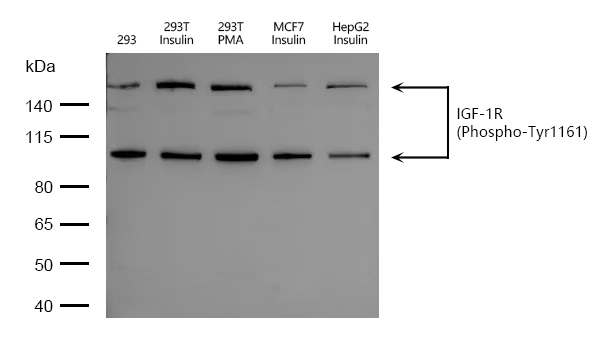Product Detail
Product NameIGF-1R(Phospho-Tyr1161) Antibody
Host SpeciesRabbit
ClonalityPolyclonal
PurificationAntibodies were produced by immunizing rabbits with synthetic phosphopeptide and KLH conjugates. Antibodies were purified by affinity-chromatography using epitope-specific phosphopeptide. Non-phospho specific antibodies were removed by chromatogramphy using non-phosphopeptide.
ApplicationsWB IHC IF
Species ReactivityHu Ms Rt
SpecificityThe antibody detects endogenous level of IGF-1R only when phosphorylated at tyrosine 1161.
Immunogen TypePeptide-KLH
Immunogen DescPeptide sequence around phosphorylation site of tyrosine 1161(D-I-Y(p)-E-T)derived from Human IGF-1R.
Target NameIGF-1R
ConjugateUnconjugated
Other NamesIGFR; CD221; IGFIR; JTK13
Accession NoSwiss-Prot: P08069
NCBI Gene ID: 3480
NCBI mRNA: NM_000875.3
NCBI Protein: NP_000866.1
Uniprot
P08069
Gene ID
3480;
Concentration1.0mg/ml
FormulationSupplied at 1.0mg/mL in phosphate buffered saline (without Mg2+ and Ca2+), pH 7.4, 150mM NaCl, 0.02% sodium azide and 50% glycerol.
StorageStore at -20°C
Application Details
Predicted MW: 95,200kd
Western blotting: 1:500~1:1000
Immunohistochemistry: 1:50~1:100
Immunofluorescence: 1:100~1:200
Immunohistochemical analysis of paraffin- embedded human breast carcinoma tissue using IGF-1R (phospho-Tyr1161) antibody (#11087).
Immunofluorescence staining of methanol-fixed MCF7 cells using IGF-1R (phospho-Tyr1161) antibody (#11087, Red).
Western blot analysis of IGF-1R(Phospho-Tyr1161) expression in 293,293T Insulin,293T PMA,MCF7 Insulin,HepG2 Insulin
Receptor tyrosine kinase which mediates actions of insulin-like growth factor 1 (IGF1). Binds IGF1 with high affinity and IGF2 and insulin (INS) with a lower affinity. The activated IGF1R is involved in cell growth and survival control. IGF1R is crucial for tumor transformation and survival of malignant cell. Ligand binding activates the receptor kinase, leading to receptor autophosphorylation, and tyrosines phosphorylation of multiple substrates, that function as signaling adapter proteins including, the insulin-receptor substrates (IRS1/2), Shc and 14-3-3 proteins. Phosphorylation of IRSs proteins lead to the activation of two main signaling pathways: the PI3K-AKT/PKB pathway and the Ras-MAPK pathway. The result of activating the MAPK pathway is increased cellular proliferation, whereas activating the PI3K pathway inhibits apoptosis and stimulates protein synthesis. Phosphorylated IRS1 can activate the 85 kDa regulatory subunit of PI3K (PIK3R1), leading to activation of several downstream substrates, including protein AKT/PKB. AKT phosphorylation, in turn, enhances protein synthesis through mTOR activation and triggers the antiapoptotic effects of IGFIR through phosphorylation and inactivation of BAD. In parallel to PI3K-driven signaling, recruitment of Grb2/SOS by phosphorylated IRS1 or Shc leads to recruitment of Ras and activation of the ras-MAPK pathway. In addition to these two main signaling pathways IGF1R signals also through the Janus kinase/signal transducer and activator of transcription pathway (JAK/STAT). Phosphorylation of JAK proteins can lead to phosphorylation/activation of signal transducers and activators of transcription (STAT) proteins. In particular activation of STAT3, may be essential for the transforming activity of IGF1R. The JAK/STAT pathway activates gene transcription and may be responsible for the transforming activity. JNK kinases can also be activated by the IGF1R. IGF1 exerts inhibiting activities on JNK activation via phosphorylation and inhibition of MAP3K5/ASK1, which is able to directly associate with the IGF1R.When present in a hybrid receptor with INSR, binds IGF1.shows that hybrid receptors composed of IGF1R and INSR isoform Long are activated with a high affinity by IGF1, with low affinity by IGF2 and not significantly activated by insulin, and that hybrid receptors composed of IGF1R and INSR isoform Short are activated by IGF1, IGF2 and insulin. In contrast, shows that hybrid receptors composed of IGF1R and INSR isoform Long and hybrid receptors composed of IGF1R and INSR isoform Short have similar binding characteristics, both bind IGF1 and have a low affinity for insulin.
Kasuya J., Paz I.B., Maddux B.A., Goldfine I.D., Hefta S.A., Fujita-Yamaguchi Y.Biochemistry 32:13531-13536(1993)
Slaaby R., Schaeffer L., Lautrup-Larsen I., Andersen A.S., Shaw A.C., Mathiasen I.S., Brandt J.J. Biol. Chem. 281:25869-25874(2006)
Wu J., Li W., Craddock B.P., Foreman K.W., Mulvihill M.J., Ji Q.S., Miller W.T., Hubbard S.R.EMBO J. 27:1985-1994(2008)





 Yes
Yes



